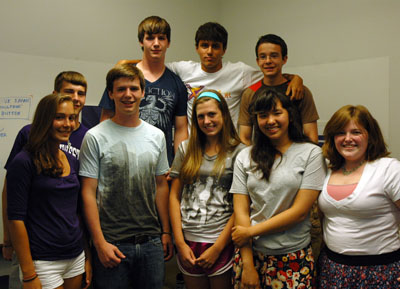ITI Hosts Summer Camp for High School Students
What does it mean to be an engineer?
This week, 14 high school students delved into just that question at the 2010 Summer High School Infrastructure Camp at Northwestern University. The answer wasn’t what they thought.
“Engineers do a lot more than build stuff,” said Jack Fuller, a 15-year-old from Evanston.
“A city is a lot more complicated than I thought,” said Martin Morales, a 17-year-old from Chicago.
The weeklong camp is an opportunity for curious teenagers to learn the basics of engineering, observe engineering at work, and try their hands at it themselves. Hosted by the Infrastructure Technology Institute and the Partnership for International Research and Education: Intelligent Structural Health Management (PIRE-ISHM), both part of the McCormick School of Engineering and Applied Science, the camp offered students lectures and a bridge-building lesson from McCormick faculty members and graduate students, infrastructure walking tours with research engineers, a visit to an Illinois wind farm, and a chance to see McCormick research at work at a Chicago Transit Authority El bridge.
The bridge carrying CTA trains across Devon Avenue is currently the site of McCormick infrastructure research. NU researchers are using sensors to monitor the structural health of this aging bridge, bringing real-time data back to the campus laboratory over the Internet.
“We tested the safety of the bridge, which is actually what you would be doing if you went into engineering,” said Bridget Hybinette, a 15-year-old from Chicago.
“The bridge didn’t look safe,” said Andy Rapoport, a 15-year-old from Skokie, “but with the sensors we were able to actually see how safe it was.”
It’s comments like these that show the success of the camp, now in its fifth year, says Elizabeth Brasher, assistant director of the institute.
“The students that attend this camp are the engineers of the future,” she says. “We want to give them the opportunity to get a hands-on experience in the different disciplines of engineering. They get classroom instruction, but the idea is to get them out to get a taste of what engineers actually do.”
The students, who came from around the Chicago area and as far away as the U.S. Virgin Islands, said they were surprised by the wind farm — how big and quiet the turbines were, how economically feasible green energy seemed — and after hearing lectures from Northwestern faculty involved in PIRE-ISHM, they said they were surprised at how cross-disciplinary engineering could be.
“The engineering fields — electrical, mechanical — they are all connected,” said William Meyer, a 16-year-old from Clarendon Hills.
The camp culminated with a river boat tour of Chicago architecture, where Northwestern faculty and research engineers pointed out structural aspects of some of Chicago’s most famous buildings and bridges.
“So many times we take for granted what we see going on around us: how did that building get there, how do we get clean water every day,” Brasher said. “Engineers make that happen, and this camp is a good way for students to get a taste of that.”
